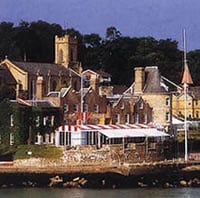Cowes
 Best
known as the world's premier yachting centre, Cowes is the Island's main port
with a natural harbour at the mouth of the Medina river. Yachtsmen from all
over the world participate in the season's prestigious sailing events, of
which the best known is Cowes
Week, held annually at the beginning of August.
Best
known as the world's premier yachting centre, Cowes is the Island's main port
with a natural harbour at the mouth of the Medina river. Yachtsmen from all
over the world participate in the season's prestigious sailing events, of
which the best known is Cowes
Week, held annually at the beginning of August.
Cowes and East Cowes grew from a huddle of fishermen's shacks around two coastal forts built by Henry VIII on opposite banks of the River Medina and named after the two off-shore sandbanks or cows. The towns are linked by an old-fashioned chain ferry and have a tradition of fine ship building, dating from the reign of Elizabeth I. Then came the yacht building industry, as sailing became a popular sport, endorsed by the royal family. In 1854, the Royal Yacht Squadron was moved into Cowes Castle, the former Tudor fort, and the name of Cowes has been synonymous with yachting ever since.
Shopping in the narrow pedestrianised High Street is a delight, with some excellent shops, many catering for the yachting fraternity. The town also has an array of fashionable clothing shops, gift shops, delicatessens, cafes, restaurants and lively pubs. The high speed passenger catamaran service to Southampton is centrally located at Fountain Quay. Above the High Street and overlooking the Solent is Northwood House and Park. This classical style mansion was built in 1837 and given to the town in 1929, together with its 26 acres of grounds, which now provide public tennis courts, bowling greens, putting green and a children's play area. At the edge of the park stands St. Mary's Church, its landmark clock tower, designed by John Nash, was retained when the church was rebuilt in 1867.
East Cowes is where you will find the magnificent Osborne House, former seaside holiday home of Queen Victoria and Prince Albert and preserved much as it was when the Queen died here in 1901. Nearby is St. Mildred's Church at Whippingham, where the royal family worshipped. Both buildings were designed by the Prince Consort.
See also:
|
||||||||||||||||||||||||||||||||||||











